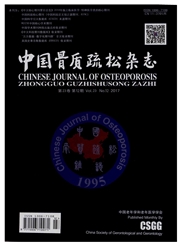

 中文摘要:
中文摘要:
目的:探讨降糖消渴颗粒对高脂饮食诱导自发性2型糖尿病KKAy小鼠肾脏c-Jun氨基末端激酶(JNK)信号通路。方法:将40只成模的KKAy小鼠按血糖、体质量随机分为模型组,吡格列酮组,中药高、中、低剂量组(每日分别以降糖消渴颗粒7.0、3.5、1.75g/kg体质量灌胃),每组8只,另设8只C57BL/6J小鼠为正常组。模型组和正常组给予蒸馏水,其余组给予对应量的药液灌胃。干预10周后,检测各组小鼠空腹血糖(FBG)、血清尿素氮(BUN)、肌酐(Scr)、白蛋白(ALB)、总蛋白(TP)的含量,用RT-PCR检测肾组织JNK m RNA的表达,Western Blot检测各组小鼠JNK1、JNK2、P-JNK蛋白的表达情况,HE染色观察药物对糖尿病小鼠肾脏病理改变的影响。结果:与正常组小鼠比较,模型组小鼠FBG、BUN与Scr水平显著上升(P〈0.05),ALB、TP水平明显下降(P〈0.05),而JNK m RNA及JNK1、JNK2、P-JNK蛋白表达明显上调;药物干预10周后能够显著降低FBG、BUN与Scr水平,升高ALB、TP水平,与模型组比较差异具有统计学意义(P〈0.01,P〈0.05);各给药组较模型组的JNK m RNA及JNK1、JNK2、P-JNK蛋白表达则表现出下调的趋势(P〈0.01,P〈0.05);HE染色显示降糖消渴颗粒对肾脏病理改变有一定的保护作用。结论:降糖消渴颗粒对糖尿病小鼠肾损伤有一定的保护作用,其作用机制可能与抑制JNK信号通路激活有关。
 英文摘要:
英文摘要:
Objective: To investigate the effect of Jiangtang Xiaoke Granules(JTXKG) on JNK signal pathway in renal tissues of type 2 diabetic KKAy mice model induced by high fat diet. Methods: 40 KKAy mice were randomly divided into 5 groups based on the glucose level and body weight: the model group, pioglitazone group, JTXKG high, middle and low dose groups(7.0, 3.5, 1.75g/kg), 8 rats in each group, besides, 8 C57BL/6J mice were used as normal group. Rats in the normal group and model group were administrated with distilled water, while the others were gavaged with corresponding drugs. After 10 weeks of intervention, the levels of fasting blood glucose(FBG), urea nitrogen(BUN), creatinine(Scr), albumin(ALB) and total protein(TP) in the serum were detected. The m RNA level and protein level of JNK1, JNK2, P-JNK in renal tissues were detected with RT-PCR and Western Blot respectively. Pathomorphologic changes of each group were demonstrated by HE staining. Results: Compared with rats in the normal group, levels of FBG, BUN and Scr were significantly increased, while the ALB and TP levels were significantly decreased in diabetic model(P〈0.05). The m RNA level of JNK and protein levels of JNK1, JNK2 and P-JNK were significantly increased in diabetic model. After 10 weeks of drug intervention, the levels of FBG, BUN and Scr significantly decreased, and the plasma protein level significantly increased excepted the low dose CHD group, compared with the model group(P〈0.01, P〈0.05). In addition, all these drugs could down-regulate m RNA level of JNK and protein levels of JNK1, JNK2 and P-JNK in renal tissues of diabetic model(P〈0.01, P〈0.05). Treatment with JTXKG alleviated the pathological changes of renal tissues in HE staining. Conclusion: JTXKG could protect the renal injury of diabetes rats, which may be related to the inhibition of JNK signaling pathway activation.
 同期刊论文项目
同期刊论文项目
 同项目期刊论文
同项目期刊论文
 期刊信息
期刊信息
